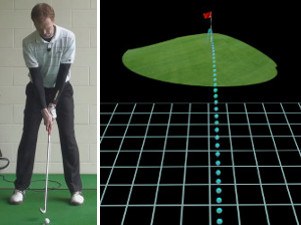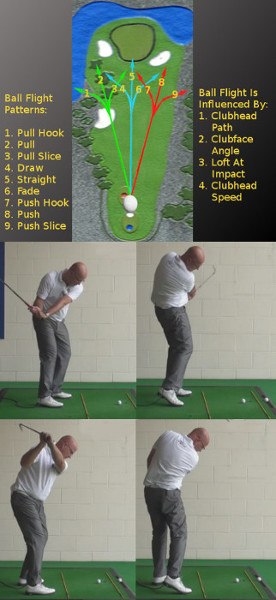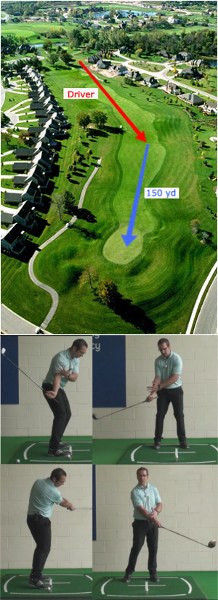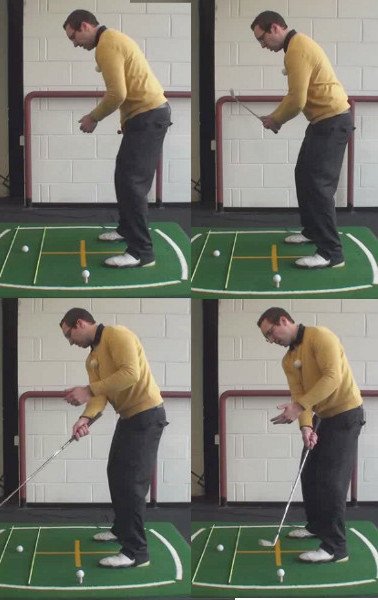
Ben Hogan once said, “You only hit a straight ball by accident.”
What did Hogan, one of history's most accurate hitters, mean? Basically, that hitting a golf ball on an undeviating line was nearly impossible, on purpose or otherwise. The clubface is almost always closed or open at impact in relation to the swing path, imparting left or right sidespin.
Knowing that, Hogan never tried to hit the golf ball dead straight. Instead, he intentionally made the ball curve left or right depending on the demands of each shot.
How do you determine whether a given shot should move left to right (a fade for a right-hander) or right to left (a draw)? The major factors are the shape of the hole and the pin placement on the green.
Generally, the best bet for finding the fairway from the tee is a shot that mirrors the hole's curvature (dogleg). For example, a golf ball fade is best on a dogleg right hole, a draw on a dogleg left.
Similar logic applies on approach shots to greens. If the flagstick is placed on the right of the green, a fade that starts left and moves toward the target is preferred, and vice versa.

Fade or Draw – Depends on the Hole
When first getting started in golf, your entire goal is to just hit the ball 'straight'. Of course, straight doesn't really mean that the ball flies in a straight line – it just means that it doesn't curve too badly in one direction or another. Hitting the ball generally straight will allow you to keep your shots in play, and you will be able to have fun on the course. For some people, reaching this level is satisfying enough, and they never really push to make it any farther.
Unfortunately, being satisfied with just hitting the ball in the general direction of the target is going to put a ceiling on your game. You won't be able to progress much beyond your current level of play unless you challenge yourself to further develop your skills. One way in which you can take your game to a new level is by learning how to hit both a fade and a draw on command. When you can plan the flight of your ball ahead of time – and then execute that plan perfectly – you will have a chance to play at a much higher level. Professional golfers play this way all the time, but you don't have to be a pro to benefit from ball flight control.
There are two specific challenges when it comes to playing this kind of golf. The first challenge is learning how to hit both a fade and a draw. Golf is hard enough as it is when just trying to hit the ball down the fairway – it gets even more demanding when you expect to control your ball flight on demand. Then, once you learn that skill, you still have to know how to apply your newfound talent properly on the course. When do you hit the draw, and when do you turn to a fade? That decision might not be as easy as it would seem at first.
In this article, we are going to address this topic from a variety of angles. First, we are going to cover the basics of controlling your ball flight. We won't be able to get down into the small details of this subject, but we will provide you with enough information to get started. Then, with that out of the way, we will talk about strategy. It is really the proper use of your ball flights which will let you get the most out of your game on the course. The golfers who are able to consistently post low scores aren't always the ones with the best swings. In many cases, they are just the players who make the best decisions.
All of the content in this article is based on a right-handed golfer. If you happen to play left-handed, please take a moment to reverse the directions as necessary.

Achieving a Custom Ball Flight
When you stand over the ball, do you know which way to expect the ball to turn in the air? If not, you are playing a guessing game each time you line up for a shot. Obviously, this is not the ideal way to play golf. It would be far better if you could plan on hitting either a draw or a fade based on the situation at hand. When you have that skill, you can base your target and your ball flight on the layout of the course. Need to stay away from a hazard, or maybe set yourself up with an uphill birdie putt? Use your ball flight to position your ball in the ideal spot.
If you are going to head out to the driving range to work on ball flight control, the tips listed below should be of some help. Remember, this is an advanced skill, and you shouldn't expect immediate progress. Be patient and stick with it until you start to see success.
- Adjust your grip. The first place to start when trying to control your ball flight is your grip. When you want to play a draw, you should use a slightly stronger grip. That means turning both hands to the right as you look down from address. Of course, to play a fade, you are going to do the opposite and use a weaker grip (by turning your hands to the left). It is important to note that these are not supposed to be major changes. You should only be shifting your hands slightly on the grip before starting your swing. A stronger grip is going to promote a more aggressive release at the bottom, which will help the ball to turn over in the air. On the other hand, the weaker grip will take your hands out of the picture, holding the club face open and promoting a fade.
- Adjust your stance. This is another adjustment which is going to take place before the swing even starts. To make it easier to hit a draw, try setting up with your body slightly closed to the target line. That means both your knees and your shoulders should be aligned to the right of the target. This kind of setup will promote a swing path which moves from inside-out, and the ball should receive draw spin as a result. If you are trying to hit a fade, open up your stance by aligning your knees and shoulders to the left of the target instead. An outside-in swing path should be the result in this case, and the ball should curve from left to right as it flies. When you combine a grip adjustment with a stance adjustment, you will have a great chance of achieving your desired outcome.
- Adjust your backswing timing. To be sure, this last point is an advanced move. A beginning golfer will not be able to make this adjustment easily, so make sure you have plenty of experience under your belt before taking this step. If you still consider yourself to fit into the 'beginner' category on the links, stick with the first two adjustments and you should still see some results. However, if you want to go a step further, you can try to adjust the timing of your backswing to encourage a draw or fade. When a draw is desired, spend a little more time in the backswing, allowing yourself to turn a bit farther away from the target before starting down. This is going to make it easier to stay behind the ball at impact, which is exactly what you need to do when trying to shape a shot from right to left. By shortening your backswing a little bit, you can achieve the opposite effect. You will keep the club overtop of your usual plane when you shorten your turn, which will promote the outside-in path needed for a fade. As always, you should work on this adjustment on the driving range before ever trying it on the course.
Many golfers assume they don't have the talent or technique to produce specific ball flights on command – so they never even try. That is a shame. Even if you aren't a great golfer, you can still work on the technique needed to curve the ball as necessary. Along the way, you might find that your 'normal' swing actually improves thanks to the work you are doing on these ball flights. Give this a try during your next visit to the range and you might be surprised by the results.

Ball Flight Strategy Basics
Countless amateur golfers fail to ever think about course management techniques. The majority of golfers simply walk up to the ball, aim at the fairway or green, and swing away. It should be no surprise that this method fails to yield any positive results. If you play golf this way, you are basically hoping that the ball will wind up close to the hole, rather than doing everything you can to make it happen.
Now that you are working on the ability to control your ball flight, you need to have some basic strategy points in mind. The three keys listed below all relate to how you can use your ball flight to navigate your way around the course successfully.
- Turn the ball away from hazards. As a general rule of thumb, you want to hit your shots in a manner such that they will be turning away from hazards as they fly. So, for example, if you are hitting a tee shot on a hole which has water running down the left side of the fairway, you will want to hit a fade to curve the ball away from that hazard. If you were to hit a draw, even slightly overdoing the draw could lead to trouble. There are some situations where you won't be able to follow this rule of thumb, but you should always keep it in mind and follow it when possible. Keeping your ball out of hazards is a great way to lower your average score, and this tip can help you do just that.
- Turn the ball into a slope. Very few golf courses are completely flat from the first hole on through to the last. You usually have to deal with slopes as you play, and you can use your ball flight to minimize the effects of those slopes on your shots. As an example, picture an approach shot into a green which is tilted severely from right to left. If you were to hit a draw into such a green, the ball would take a big bounce to the left when it lands – and it would probably keep rolling until it was all the way off the putting surface. On the other hand, if you fade the ball into this kind of green, you may be able to get a gentle bounce. The shape of your shot and the slope of the ground will counteract one another, and the result will be excellent. Whenever possible, try to shape the ball opposite to the slope of the turf in order to limit the bounce and roll on your shots. Of course, there are a few occasions where matching your ball flight to the slope will be best. A great example of this concept is a tee shot on a dogleg which both turns and slopes to the left. Hitting a draw on this kind of shot will promote a big bounce that only takes your ball closer to the green. Think about whether or not you want to see a big bounce on the shot at hand and then pick your ball flight accordingly.
- Turn the ball back into a dogleg. When you stand on the tee of a par four or par five hole with a dogleg, you probably think first about matching the turn of your shot to that curve. While that s strategy can work in some cases, you may actually find more success by going in the opposite direction. In other words, when playing a hole which turns from left to right, consider hitting a right to left tee shot to widen the effective landing area you have available to use. The geometry of this kind of shot dictates that the fairway will be wider when using this method, and you might even be able to push the ball farther up toward the green as well. Obviously, before you use this technique, you will need to make sure that you have the airspace necessary to do so. If there are trees located on the inside of the dogleg, you aren't going to be able to take the backdoor into the fairway.
The tips above are a great place to get started from a strategy perspective, but you will also simply need to gain some experience in order to make the right call more times than not. As you play more and more golf with your new ball flights, you will find your own ways to use them effectively.

The Distance Factor
In addition to considering the shape of your shots when picking between a draw and a fade, you also need to keep in mind the distance implications. Generally speaking, a draw will travel farther than a fade when all is said and done. That is not something which is set in stone, but it is going to be true for most players. So does that mean you should always play a draw, since it is likely to travel farther? Of course not. There are plenty of occasions where a fade will be the right call, even if that means sacrificing a little bit of potential distance along the way.
To gain a better understanding of this topic, let's look at a sample situation. Imagine you are standing on the tee of a par five with your driver in hand. You are obviously trying to hit the fairway, and you would love to rip the ball as far down the fairway as possible in order to maybe reach the green in two shots. This is a situation which is nicely setup for a draw. You can play your draw down the right side of the fairway, let it turn back to the middle, and watch it run. When executed properly, this type of shot will give you the best possible chance of reaching the green with your second shot.
But hold on. What if this hole happens to have a narrow fairway, and the course features rather deep rough once you venture away from the short grass? In that case, you might actually be better off playing a fade. Even though the fade is not going to travel as far, it will offer you better control over your golf ball. The ball will settle in the fairway faster thanks to a higher backspin rate, meaning you won't need to worry so much about the ball landing in the fairway only to bounce off into the rough. Taking this plan might mean you have to layup with your second shot, but at least you can keep the ball in play and stay on track for nothing worse than a par.
As you can see, the distance equation cuts both ways. Sure, it is great to hit the ball far, but that distance only helps if you can keep the ball on the short grass. In some situations, it will be better to use the fade as a means of control, while knowing that you will give up some yardage in the process. Remember, the goal is to shoot the lowest score possible – and shooting a low score doesn't always correlate with hitting long shots.
Another way you can use ball flights to improve distance management is when you are in-between clubs on an approach shot. All golfers know the feeling – you check the yardage to the hole and find that the number is exactly between two of your clubs. So what do you do? When you have both a draw and a fade at your disposal, you can go a couple of different ways. You could choose to use the shorter club and hit a draw, or you could hit the longer club and fade the ball into the target. Either way, the added or lost distance should bring you nicely within range of the hole.
As you get used to your new ball flights and you find more and more ways to use them, remember that distance control is a big part of this picture. Don't just think about the shape of your shots in terms of right and left, but also think about the total distance they will travel. With a little experience, you will find that being able to hit both draws and fades will give you more control over your game than you ever thought possible.

Some Final Thoughts
Before we wrap up this article, we wanted to highlight a few final points related to hitting draws and fades.
- Have a go-to shot for pressure situations. When you are feeling pressure on the course, you want to have a shot that you know you can trust. With that in mind, think about which ball flight gives you the most confidence and use that one when the heat is on. Even if it might not be the perfect shot for the situation, going into your comfort zone during a nervous moment is always a good idea.
- Keep your curves to a minimum. It is a great thing to be able to hit both draws and fades depending on the situation. What you don't want to do, however, is hit hooks and slices. The ball flights you use on the course should be modest in terms of how much they curve. If you are whipping the ball wildly from side to side as you make your way around the course, it will be difficult to control the final destination of your shots.
- Draw works best from a rough lie. If you find your ball in a spot where you have a difficult lie to deal with, consider using your draw to make it easier to achieve solid contact. A draw swing is going to approach the ball from a strong position on an inside-out path – perfect for conquering a bad lie and still coming away with a quality shot.
As an amateur golfer, you might think that playing draws and fades on purpose as you go around the course is something which is over your head. That is the wrong way to look at this topic, however. Instead, you should be thinking about how much your game can improve by dedicating yourself to learning this skill. If you manage to pull off even just a few draws or fades when the time is right during an upcoming round, you could save multiple strokes. Challenge yourself to develop this skill and your game is going to move in the right direction. Not only will you be able to shoot lower scores, but you will probably have more fun on the course as well. Good luck!






